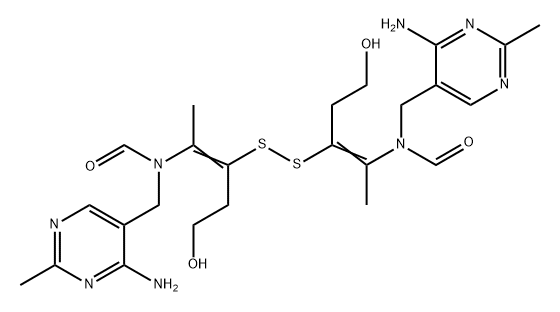Chemical Properties
White Solid
Originator
Arcalion,Servier,France,1974
Uses
Thiamine is a essential nutrient required for carbohydrate metabolism; also involved in nerve function. Biosynthesized by microorganisms and plants. Dietary sources include whole grains, meat products
, vegetables, milk, legumes and fruit. Also present in rice husks and yeast. Converted in vivo to Thiamine diphosphate, a coenzyme in the decarboxylation of α-keto acids. Chronic deficiency may lead t
o neurological impairment, bariberi, Wernicke-Korsakoff syndrome.
Uses
Thiamine disulfide is an antioxidant, inhibiting lipid peroxidation in rat liver microsomes and free radical oxidation of oleic acid in vitro. Thiamine disulfide has been explored as a potent inhibitor of HIV-1.
Definition
ChEBI: Thiamine disulfide is an aminopyrimidine, a homoallylic alcohol, a member of formamides and an organic disulfide.
Manufacturing Process
20 parts by weight of thiamin are dissolved in 25 parts of water, a cold
solution of 5 parts by weight of caustic soda in 25 parts of water added and
the mixture oxidized with a solution of 2.4 parts by weight of caustic soda and
20 parts by weight of potassium ferric cyanide in 80 parts of water while
stirring in the cold. The liquid is then evaporated to dryness and the resulting
oxidation product extracted with warm butyl alcohol.
The butyl-alcoholic solution is evaporated in vacuo and the residue dissolved
with gentle heating in 25 parts by volume of methyl alcohol. 100 parts by
volume of acetone are added, the solution filtered and further quantities of
acetone added, whereupon crystallization sets in. Yield: 12.2 parts by weight
of the pure product, having the melting point 177° to 179°C.
Therapeutic Function
Enzyme cofactor vitamin
Biological Activity
Thiamine Disulfide can be reduced by glutathione and thioredoxin (Trx) systems. In Caco-2 cells, thiamine disulfide derivatives did not alter the total thiol content, but it was significantly reduced by simultaneous inhibition of TrxR. When oxidative stress was induced by tert-butyl hydroperoxide, thiamine disulfide exerted a protective effect, indicating that the thiol form generated by disulfide reduction may be the active species. In addition, thiamine disulfide was shown to increase the nuclear levels of the transcription factor nuclear factor erythroid 2-related factor 2, and stimulate the expression and activity of NAD(P)H quinone dehydrogenase 1 and TrxR. However, other enzymes of the glutathione and Trx systems were barely affected
[1].
References
[1] FOLDA A, SCALCON V, TONOLO F, et al. Thiamine disulfide derivatives in thiol redox regulation: Role of thioredoxin and glutathione systems[J]. BioFactors, 2024, 3 1. DOI:10.1002/biof.2121.



